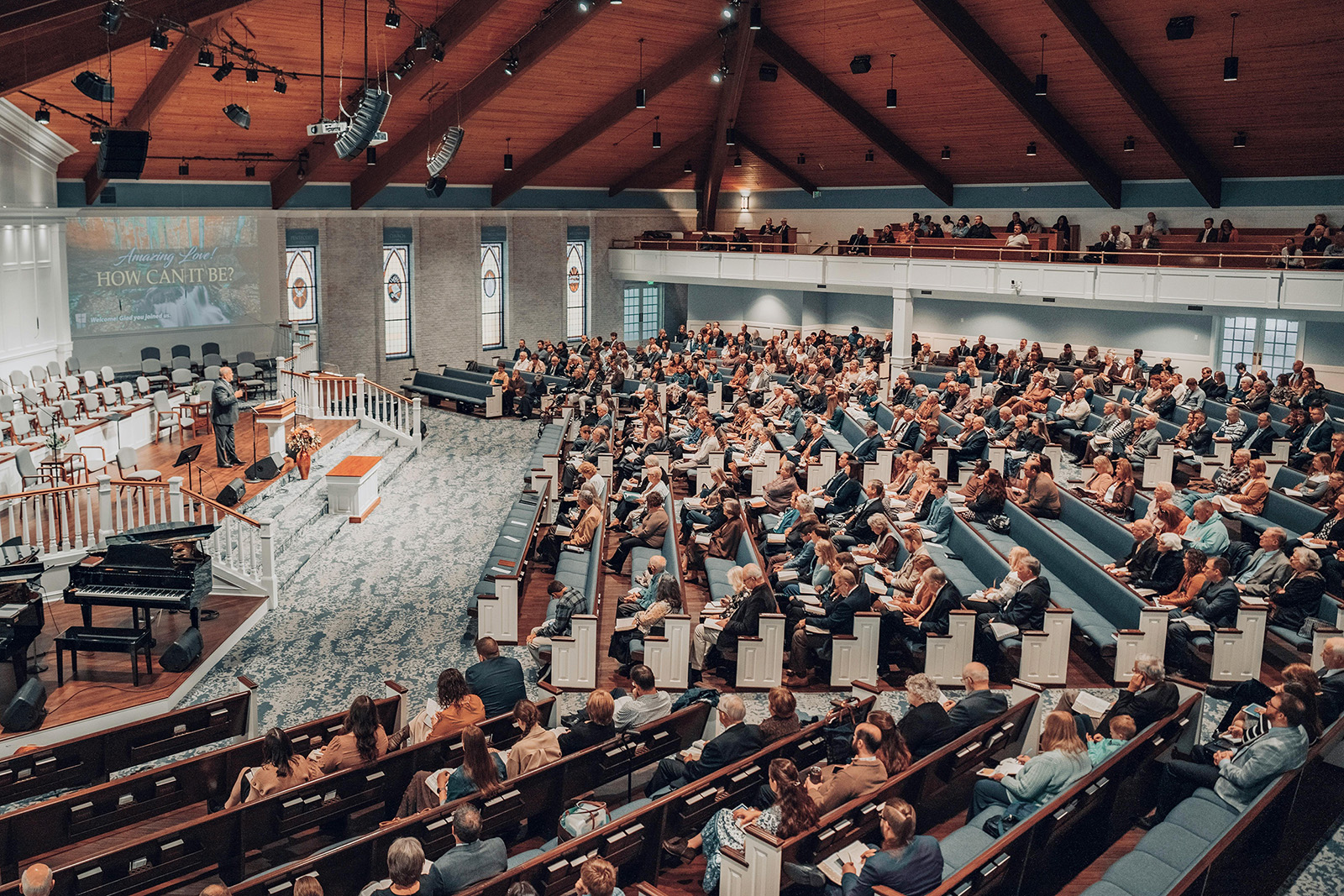
(RNS) — Five years after the start of the COVID-19 pandemic, almost half of churchgoers are regular participants in congregations other than their primary one, either attending in person, watching online or on TV, or taking part in both physical and virtual offerings.
Researchers for the multiyear Hartford Institute for Religion Research study found that 46% of some 24,000 churchgoers responding to their survey reported active engagement with more than one church.
Engaging in other congregations did not prevent these churchgoers from giving and volunteering at the primary church in their lives, said Scott Thumma, principal investigator of the Exploring the Pandemic Impact on Congregations study.
“(P)articipating in multiple services regularly did not detract from one’s commitment to one’s home church,” he said, “rather it was as if these highly committed religious persons wanted/needed more spiritual sustenance than their one church provided and sought out this nourishment elsewhere while remaining as involved in their home church.”
Of the tens of thousands surveyed, half were evangelical Protestant (50%), one-third were Catholic or Orthodox (32%), and 18% were mainline Protestant. About 7 in 10 worship at churches with 250 or more attendees (71%), the majority attend churches that offer online services (85%), and one-fifth are part of multiracial congregations (19%).
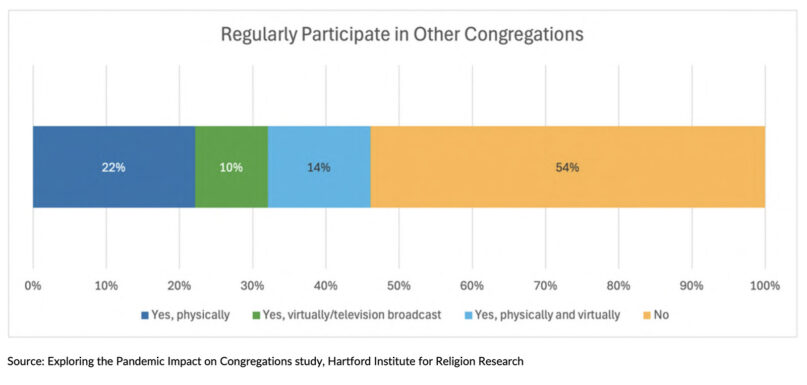
“Regularly Particpate in Other Congregations” (Graphic courtesy HIRR)
Project researchers, who have previously surveyed congregational leaders, said the most recent research, released Monday (June 16), looks at the behaviors and attitudes of those most likely to be attending church.
RELATED: Most pastors say their churches will survive — and for now, they’re right
“From the perspective of the 24,000 church attenders we surveyed, the picture that emerges is largely positive,” reads the introduction to the 36-page report, “This Place Means Everything to Me: Key Findings from a National Survey of Church Attenders in Post-Pandemic United States.”
“Many more respondents said their religious faith and spirituality had strengthened since the pandemic. Likewise, financial giving has increased, as has involvement and volunteering,” according to the report.
Researchers found that 3 out of 4 churchgoers say they take part in worship services primarily or exclusively in person. About one-fifth (19%) say they attend a mixture of online and in-person services, and 7% say they exclusively or primarily attend online.
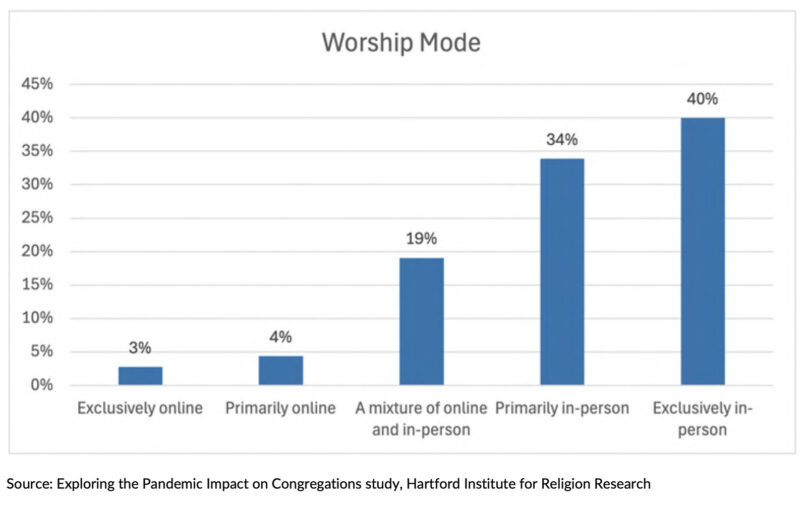
“Worship Mode” (Graphic courtesy HIRR)
“When comparing the respondents who attend in person with those who tune in virtually, the former are more likely to volunteer with the congregation, attend more frequently, and have more close friends in the congregation,” the report reads.
While evangelical church attenders were more likely than people in other faith groups to be virtual participants, Black church participants were less likely than those of other races to attend in person. Catholic and Orthodox churchgoers were much more likely to opt for in-person attendance, with the centrality of the weekly Eucharistic ritual a likely factor.
About two-thirds (64%) of online worshippers acknowledged that they multitask while watching or listening to services, but almost all (95%) say they pray or meditate during the service and most read or sing along (79% and 71%, respectively) with in-person congregants.
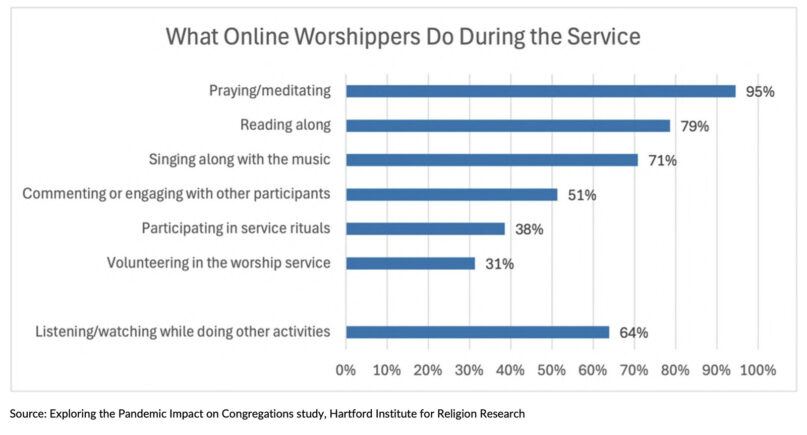
“What Online Worshippers Do During the Service” (Graphic courtesy HIRR)
Overall, besides worship services, participation in other religious activities and programs — such as religious education, music, social groups or fellowship activities — has increased or remained the same in the last five years. A majority maintained their engagement level in the wake of the pandemic, while 25-32% of respondents increased their participation and 13-17% have decreased.
Evangelical church attenders reported high attendance in most of the programs except community service, an activity in which mainline church congregants were more likely to note increased participation.
Black church attenders reported higher levels of participation in all the activities than congregants at other churches. Despite the finding that Black church attenders are less likely to worship in person, this subgroup of congregants is nevertheless among those who have considerable small group participation.
A sizable percentage — 38% — of respondents said they had started attending their current church within the last five years.
“Interestingly, among the new attenders in the survey, 22% report not having attended a congregation for years and 8% indicate they never participated in a congregation before the one they currently attend,” the report notes. “This combined 31% of new attendees represent former religious ‘nones’ or congregational converts who are embracing organized religion for the very first time in their lives or returners who have been ‘re-churched’ after a lapse in participation.”
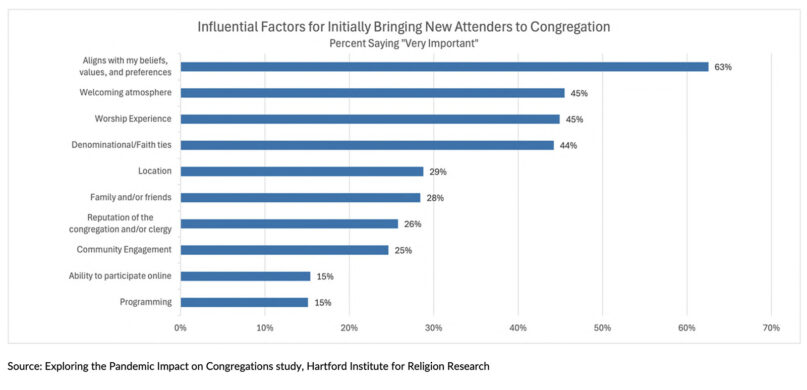
“Influential Factors for Initially Bringing New Attenders to Congregation” (Graphic courtesy HIRR)
By far, the most influential factor that drew new congregants to a church was an alignment with their values, beliefs and preferences (63%). More than 4 in 10 cited a welcoming atmosphere (45%), the worship experience (45%) and the denominational/faith ties (44%).
Almost two-thirds (61%) of those surveyed were women, 73% were white and 10% were immigrants (and 27% were children of immigrants).
Thumma cautioned that the survey results likely paint a rosier picture because they are based on the views of active participants. A survey of church leaders, he said, may offer a broader sense of the state of a congregation, including the very committed members and people who are less so. He also noted that five years past the start of the pandemic, churchgoing patterns — from attendance to giving to religious education — continue to shift.
“So far, no two surveys we have done record a static ‘back to normal’ reality has been established,” he said in an email to Religion News Service. “Things are still in flux. The impact of the pandemic on congregational life has a long tail of influence.”
The findings are from a survey of a total of 24,165 adults representing more than 80 denominations, with an overall margin of error of plus or minus 0.6 percentage points. They were based on responses from congregations requested by the Faith Communities Today partnership (12,658) and supplemented by responses to two other panels, Survey Monkey Audience (2,784) and Prolific (8,723). Respondents from the latter two sources were selected and screened based on church attendance of at least a few times a year, not counting funerals or weddings.
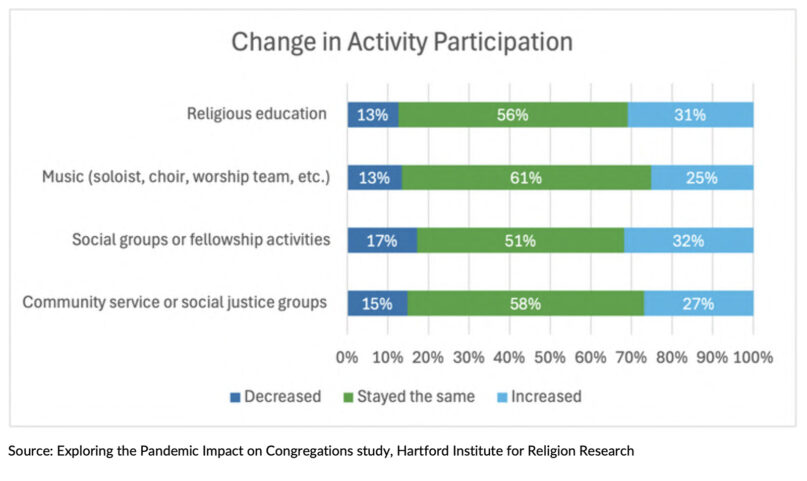
“Change in Activity Participation” (Graphic courtesy HIRR)
RELATED: Study: Religious attendance dips slightly after pandemic
